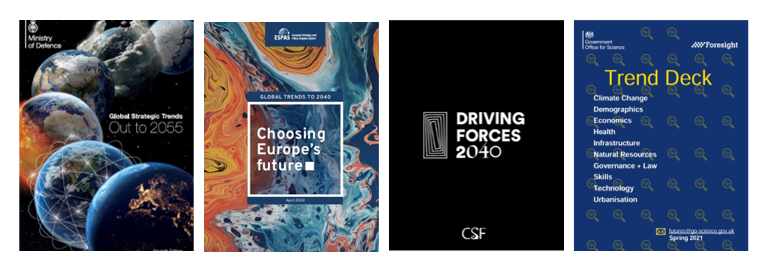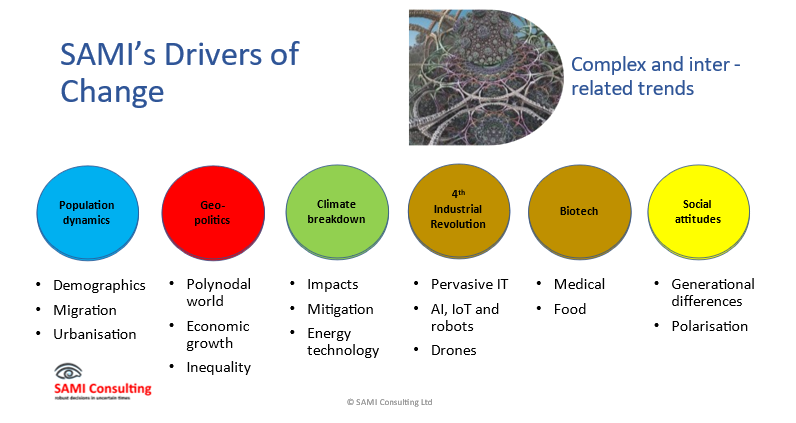SAMI continues to maintain and track key drivers of change through ongoing horizon scanning, and we noted a couple of years ago that the rate of change was increasing. In this latest update, we pick out some of the more important recent changes that we have seen and offer these up as an input into your foresight exercises.
SAMI of course are by no means the only organisation to identify and track trends and drivers. Four of the most important ones are shown below:
Global Strategic Trends, Ministry of Defence, 2024 (MOD)
Choosing Europe’s Future, European Strategy and Policy Analysis System, 2024 (ESPAS)
Driving Forces 2040, Centre for Futures Studies, Singapore, 2022 (CSF)
Trend Deck, Government Office for Science, 2021 (GOS)

We reviewed the ESPAS one last April.
Naturally, there are many commonalities between these global trends – the top 5 trends are pretty much universal. The table below is a brief comparison of what each one covers.
TREND | MOD | ESPAS | CSF | GOS | SAMI |
Geo-politics | X | X | X |
| X |
Demographics | X | X | X | X | X |
Climate change | X | X | X | X | X |
Technology | X | X | x | X | XX |
Economy | X | X | X | X | X |
Inequality | X | X |
|
| x |
Energy transition | x | X | X |
| x |
Health |
| X |
| X |
|
Work/Skills |
| X | X | X |
|
Democracy/ governance | x | X | X | X |
|
Globalisation | x |
| X |
|
|
Cities Urbanisation |
|
| X | X | x |
Industry |
|
| X |
|
|
Families |
|
| X |
|
|
Metaverse |
|
| X |
|
|
Data |
|
| XX |
|
|
Social media |
|
| XX |
|
|
Disinformation |
|
| X |
|
|
Infrastructure |
|
|
| X |
|
Natural resources |
|
|
| X |
|
Generational change |
|
|
|
| X |
(X represents a top-level trend, x a lower-level one; XX means there are two trends in that category).
Generally, the aim is to produce a manageable number of trends that can be presented to decision-makers or those working on foresight projects, so sometimes different trends are presented together.
SAMI’s six global drivers remain unchanged at the top level and are shown below.

It is interesting to note that none of the other sets explicitly pull out Biotech or Social Attitudes as top-level trends.
In a recent blog post we discussed the interplay between demographics and migration that might see Western countries having to compete for immigrants. Falling fertility rates – where due to women’s education, cost of living or fears for the future – are leading to aging populations with high dependency rates. A particularly extreme example is South Korea, with a fertility rate of 0.72 babies per woman, well below the 2.1 replacement rate. The country’s population could halve by the end of the century.
Geo-politics has of course come to the top of everyone’s list of uncertainties these days. Looking beyond current conflicts and threats (including China/Taiwan), and their impacts on supply chains (grain supplies to Africa, shipping in the Gulf and Taiwan’s dominance in semi-conductors), we can see that fundamental forces continue the trend towards a polymodal world as we noted many years ago. As well as the creation of competing super-power blocs and forces affecting the UK/EU relationship, we need to watch the positioning of middle tier countries, and the increasing influence of the global south.
Climate breakdown
2024 produced no new commitments to reduce emissions. Analysis of current commitments by Climate Action Tracker suggest we will reach a temperature increase over pre-industrial levels of 1.9˚ C in the “optimistic” scenario that all announcements are delivered. 80% of scientists at the Intergovernmental Panel on Climate Change (IPCC) foresee at least 2.5˚ C; 50% expect 3˚ C.
“Climate whiplash” - a rapid swing between very wet or dry conditions – is increasing rapidly. The underlying cause for whiplash events is that a warmer atmosphere can hold more water vapour. This means more torrential downpours when it rains but also more intense drought when it is dry, as the thirstier atmosphere sucks up more water from soil and plants. The floods more easily run off hard ground rather than being absorbed.
A major concern is “tipping points”, where runaway feedback loops kick in. Canadian wildfires melted the permafrost releasing even more carbon into the atmosphere, and continued warming melts even more.
As well as extreme weather events, climate breakdown contributes to eco-system collapse. There is a suggestion that we are entering a “6th mass extinction”.
There is room for optimism. Wind and solar power are now cheaper than fossil fuels, so reaching Net Zero is primarily a matter of political will. Other technologies – eg tidal, hydro – are looking promising, and many new energy storage systems are being developed, including green hydrogen which has important applications in shipping. Others such as geo-engineering are yet to be shown to be viable.
Grid systems need to adapt to these new energy sources – pylons from the North Sea, de-centralised multi-directional grids for local solar power, especially in rural areas.
Fourth Industrial Revolution
The pandemic drove everything online, and now generative AI is sweeping the world. The latest innovation is “Agentic” AI - systems that are designed to autonomously make decisions and act, with the ability to pursue complex goals with limited supervision. It brings together the flexible characteristics of large language models (LLMs) with the accuracy of traditional programming. Agentic AI can adapt to different or changing situations and has “agency” to make decisions based on context.
There remain many challenges with AI. How many jobs will it displace, or will it create new ones? Will the technology be dominated by China, meaning the AI will have been trained on Chinese experience and principles? How much autonomy are we prepared to grant – choosing what music to play is one thing, selecting military targets another? Also AI has huge energy and water demands.
“Artificial General Intelligence” still appears a long way off, though several leading scientists have argued we need to start preparing now (see our blogpost).
Other aspects of the fourth industrial revolution are:
“smart countryside”: internet of things and AI driving precision agriculture
drones: a major feature of the Ukrainian war
3D printing: local, just-in-time, very valuable in rural areas or disaster zones
Bio-technology is now opening up many other new opportunities and AI analysis can identify solutions more rapidly. CRISPR/Cas-9 allows for gene therapy and human enhancement, and has agricultural applications such as drought resistant cattle and crops. A new technique – epigenome editing – offers even more precision, allowing genes to be switched on and off.
Neuro-technology is on the road to science fiction. The goal is to be able to translate brain impulses and convey them across the web as a form of telepathy. More immediately useful is its application in reducing Parkinson disease symptoms.
Lab-grown meat is being examined by the Food Standards Agency. It is already on sale in Singapore, United States and Israel. Cruelty-free foie gras could become very popular. More importantly, we are also seeing developments in the field of lab-grown organs for human transplant.
Changing social attitudes - generational differences
Attitudes developed when coming of age now seem to stay with people as they grow older. We are seeing a value shift across generations as Gen Z is exposed to greater diversity via social media and travel. They have more flexible attitudes to gender. Gen Z (and millennials) have encountered greater financial insecurity: terms like “Generation Rent”, and “Boomerang children” capture some of their problems.
Younger generations drink less (“sober curious”) and smoke less. Drug use is falling amongst young – from 30% in 2002 to 17.6% in 2023. They also suffer from more mental health issues – anxiety and depression. A recent author suggested this due to smartphone usage, but there are other factors that we discussed in some detail in a recent blogpost.
Wild cards
As well as incorporating trends into your foresight work, it is worth considering a range of “Black Swans”. A list of these could pretty much go on forever, so it will be necessary to select ones that are particularly relevant to your work.
Our list includes:
Atlantic Meridional Overturning Circulation tipping point, which would disrupt the Gulf Stream: 95% confidence range for a collapse between 2025 and 2095
Another pandemic; pandemic for crops: Research published in 2022 found that the chance of a pandemic, with a similar impact to COVID-19, is about 1 in 50 in any year (or about 50% in 35 years)
Solar flares, satellite collisions, space warfare
Ecological collapse – bees etc
Catastrophic methane release
And a positive one: AI transforms economies creating an age of leisure
Coping with change
The whole panoply of Futures Thinking tools, such as those in the GO-Science Futures Toolkit, can come to your help when coping with the uncertainties of change. From shorter-term forecasting to flexible scenarios, you can think about how you respond in different situations. You can also build resilience to whatever might hit you, and the agility to respond quickly. Ideally you should aim to be “anti-fragile” – ending up stronger than you were before.
Getting help
If you need help thinking about how these trends might affect you and what you can do about it, do get in touch SAMI.
This post was based on a presentation we gave to our “post-grad” Cohort group. We would be happy to help you kick off your foresight work by taking your team through it too.
Written by Huw Williams, SAMI Principal
The views expressed are those of the author(s) and not necessarily of SAMI Consulting.
Achieve more by understanding what the future may bring. We bring skills developed over thirty years of international and national projects to create actionable, transformative strategy. Futures, foresight and scenario planning to make robust decisions in uncertain times. Find out more at www.samiconsulting.co.uk
Image by Gerd Altmann from Pixabay

Comments